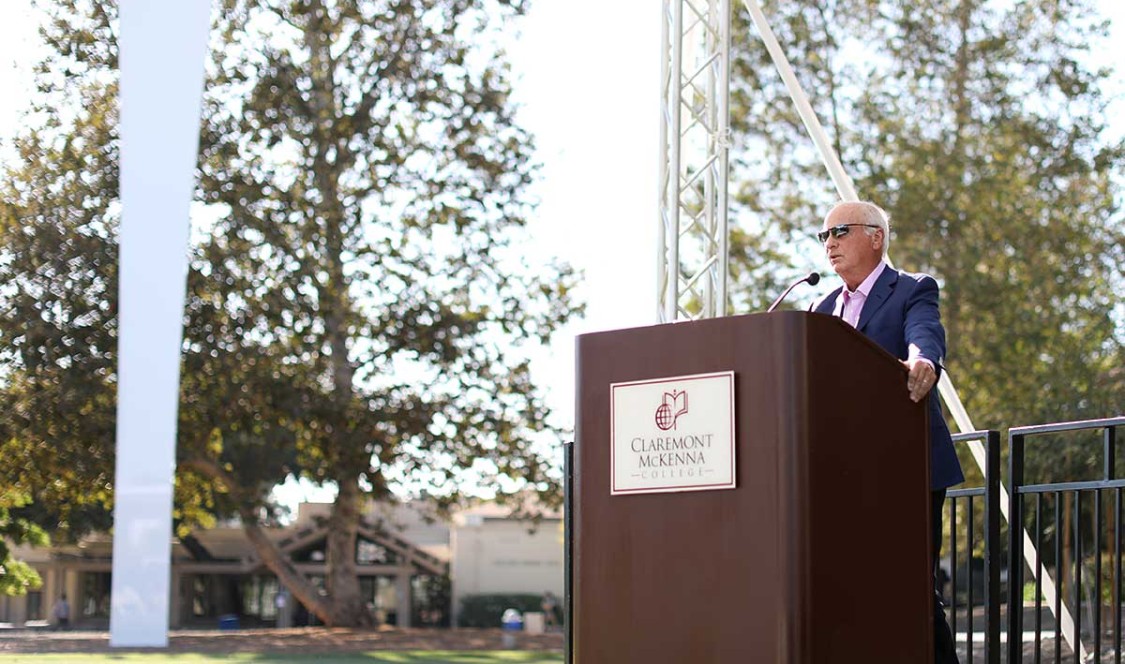As a CMC student, George Roberts ’66 P’93 spent a summer interning in New York City. He was determined, he said, to have fun. That did not include hanging out at art museums.
But shortly before returning to Claremont, he accompanied an aunt to the Metropolitan Museum of Art, Museum of Modern Art, Whitney Museum of American Art, Guggenheim, and Frick Collection. To Roberts’ surprise, being pushed outside his comfort zone helped him gain an appreciation for how art “has affected humankind (emotionally) since the very beginning.”
“It got my curiosity going, and I came back my senior year and decided to take an art history class. As I got older and was able to afford to collect a little bit, that piqued my curiosity even more,” said Roberts, a CMC trustee and co-founder, co-chairman, and co-CEO of private equity firm Kohlberg Kravis Roberts & Company.
“When you look at art today, and look at the pieces at the school, it’s got to create some kind of human emotion. It makes you think. And for me, it calms me down—a beautiful piece of art.”
With that same spirit of emotional and intellectual discovery, President Hiram E. Chodosh welcomed George and Linnea Conrad Roberts to campus this week for Celebrating Public Art, a formal dedication of two CMC art pieces funded by the couple—Meet in the Middle (2016) by Chris Burden and an untitled totem structure (2017) by Ellsworth Kelly. Meet in the Middle, a circular arrangement of eight street lamps and 24 benches in front of Roberts Pavilion, was designed as part of Burden’s work with vintage street lamps—which includes Urban Light at the entrance of the Los Angeles County Museum of Art. Kelly’s sculpture, placed nearby at the site of the original Story House, is made of stainless steel, painted white, and approximately 40 feet high. It has been compared to an Egyptian obelisk—a dual function visual landmark and place for contemplation.
“The impact of a powerful piece of public art is incalculable. The impact of two more than doubles this effect,” Chodosh said of Roberts’ gifts to campus. “Public art inspires us to see the world in new ways—intervening forms sharpen our view to see what is already there, provide a visual expression that moves us emotionally, and trigger a more abstract thought or value we cherish.”
“Just as Kelly elevates us, Burden brings us together. Just as George and Linnea elevate us today, and bring us all together here,” Chodosh added. “Now it is our responsibility to make the most of their inspiration.”
Art shapes thinking
The Burden and Kelly pieces followed painter Mary Weatherford’s 2014 mural From the Mountain to the Sea in the Marian Miner Cook Athenaeum, which was sponsored by CMC’s Public Art Committee. All are part of a wider initiative from donors like Roberts, the Public Art Committee, Student Arts Council, Gould Center, Mellon Roundtables on Creativity, Empathy, and Courage, and Sontag Center for Collaborative Creativity to complement one another and empower artistic endeavors on campus.
Mary Beebe, director of the Stuart Collection at UC San Diego and a keynote speaker at the ceremony, said CMC is fortunate to have campus stewards who believe in the value of public art. The Stuart Collection, a model for CMC’s art initiative, views the entire San Diego campus as potential sites for commissioned sculpture. It’s why public art is so special, she says: Anyone can experience it. People just have to “pay attention.”
“If you pay attention to your surroundings, then you are bound to learn a lot,” said Beebe, who also worked with Burden and Kelly when they were alive. “With these kinds of amazing pieces, you’re not decorating the campus on a cosmetic level. Colleges are providing experiences for people, especially students, to engage with the world and learn about themselves.”
Inspired attention
Christopher Walker ’69, a CMC trustee and chair of the Public Art Committee, hopes CMCers spend time reflecting with both pieces. While he was drawn to art at an early age—Walker remembers being fascinated by Pablo Picasso as an eight-year-old—he did not yet know why that was the case.
“You don’t always have to understand what art conveys. For it to reach you on an emotional level, based simply on shapes and colors, that’s the important reaction,” Walker said.
“Ultimately, art should inspire. And it should certainly celebrate creativity, which, to me, is one of the highest forms of human achievement.”
The bar CMC and Roberts set with Burden and Kelly is not only a testament to the college’s investment in creativity and ingenuity, Walker said, it’s also a further call to action. Walker has hosted four artists “with international reputations” at CMC for the possible commission of a third sculpture that he will underwrite. Their reactions to the Burden and Kelly pieces have been fascinating to witness—and serve as inspiration for what is to come.
“It’s been a profound experience, to see how the existing sculptures on campus have influenced the thinking of the artists I’ve asked to make proposals. They are truly excited by the possibility of their work not just being in a private home where only a few people see it, but in an academic environment where generations of students will be inspired,” Walker said.
“This is just a start,” he added. “I’d like to think that every three to five years we’ll be able to commission a new sculpture for CMC. That is my ambition.”
—Thomas Rozwadowski

